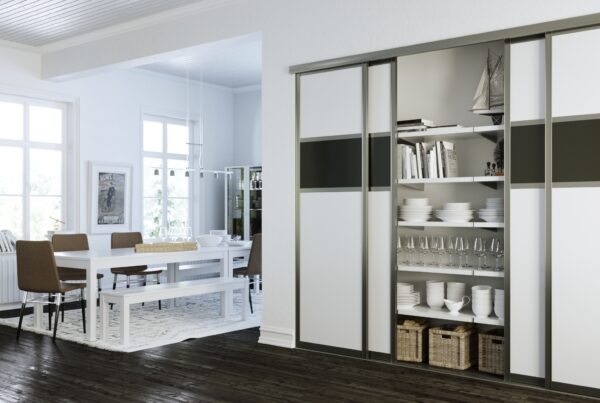Real-time 3D is a cutting-edge technology, perhaps best known from the world of video games, where it has been used for many decades. Real-time 3D rendering means that animations and images are rendered so fast that to the human eye it looks as if we were experiencing it in real life. Today, the technology has started to be used in other areas as well, transforming entire industries. For example, companies that embrace the technology can allow their customers to experience their future home before construction has even started, which is a major marketing advantage.
What is real-time 3D rendering and how does it work?
One could say that 3D rendering is a multi-step process where graphic content is created using software that generates a 2D image from a digital three-dimensional scene. Real-time 3D rendering involves building a digital model that can be turned and rotated. So it’s not just a still image but you can rotate the model and see it from all different angles. Unlike still image rendering, real-time rendering also allows you to make changes to the model and see the results directly on the screen.
To give a more technical explanation, the product to be displayed in 3D is made up of triangles. So you create a model of triangles, making one triangle at a time and placing them in a specific position (width, depth and height) for each point at which a triangle should be placed. Then make a rectangular plane of the triangle. There are also shortcuts to make many polygons quickly, instead of placing one at a time. In the end you have a model consisting of a few hundred, a few thousand or a few hundred thousand triangles. For example, to create a moving box, it is a simple model that has only 6 sides when closed. Then you use twelve triangles. However, if you want to create a sofa that has many soft, rounded edges, you will need to add many more triangles to achieve the soft shape of the sofa.
There are also many different types of lighting that can be used to create a beautiful and realistic reproduction of the sofa. The more the technology advances, the more we can compare 3D lighting to real-life lighting and match the real-life properties of light. An important part of creating realistic images is to work on creating reflections by working with light and shadows. Where light does not reach, shadows are created. How an object is illuminated is important and the reflections are created depending on how the light falls on the object. Here, the strength of the light and the surface of the object play a major role.
Benefits of real-time rendering
Comparing still image rendering and real-time rendering, real-time rendering allows you to move the camera to see how an object looks from different angles in real time. With real-time rendering, it is possible to zoom in and study every little detail of an object. You can also experiment with the appearance of the object by changing the color and material, for example.
On a car, you can experiment with its appearance by changing the color of the paint or replacing the rims, for example. This allows you to find out how different accessories fit together. All changes are displayed in real time, so you can see how different designs look the second a change is made. Real-time rendering therefore creates new opportunities for companies and also for their customers.
The technology allows, for example, architects and designers to test their ideas and see how it would look in reality. This also brings great benefits for marketing. Customers have the opportunity to experience their future home even before the construction process starts. Customers can also experiment with interior details and try different combinations of wall colors, wallpaper, flooring and more.
In which industries does 3D rendering work best?
3D rendering is widely used in many industries, of which the video game industry is perhaps one of the best known. But 3D rendering is also used by architects, product designers and in the advertising and film industry, to name a few other areas. 3D rendering really works in all industries. Especially if you have a product offer, a physical product.
If you want to render images, it is possible to render a product with a quality fully comparable to professionally taken photographs. The difference is that if you have a rendered image of a product, you can extend its use in a completely different way. Large global companies working on high-end or premium products usually have digitally rendered images and 3D models of their products. Maybe they work with traditional product photos as well, but there is a lot to gain from using 3D rendering. In the past, this technology was mainly used by large companies with a lot of money, but it is now being used more widely by small and medium-sized enterprises, as it is more cost-effective.
The automotive industry
Real-time rendering in the automotive industry is very beneficial. On the one hand, car dealers do not have to have every combination of seats and rims in the showroom, but customers can still see and experience all the designs and combinations available for a specific car. Customers can experience the car in its real size and see how different versions match. This is a huge difference compared to just seeing a picture of the car in a brochure, which you normally do if the dealer does not have that particular car in stock at the moment.
E-commerce
3D rendering is a major boost to e-commerce because it allows companies to showcase their products to customers in a completely new way, as if they were experiencing the products in real life, in a physical store. 3D rendering allows customers to interact with a product and see it from all possible angles. If a customer is buying a bag, 3D rendering gives them a completely different experience of the bag than if there were only still images of it. When the customer can also configure the product himself, the customer experience reaches new heights.
Manufacturer
Manufacturers can benefit from 3D rendering by creating a real-time 3D digital model of a product and checking that the different parts work properly before the product is manufactured.
It is also possible to plan an entire lab. By creating many different 3D models and placing them in context, you can make sure that all the parts really work together.
Unlike a 2D sketch, with AR and VR you can actually put a product into an existing lab and see if it fits. It is possible to check that the product does not hit the ceiling, for example, which is difficult to see on a 2D sketch from above. Perhaps you realize that the product needs to be connected to a plug that is 2.5 meters high and you need a ladder to reach it. So 3D offers many advantages also in terms of planning.
Animech also offers Anipart which can be used to create, update and distribute service manuals. The real-time 3D manuals provide user-friendly guidance on how to service products, what spare parts to order and where to place all the different components. Anipart can also be used to demonstrate how to disassemble and assemble a product. If the manufacturer has a 3D manual, it is much easier for them to train and maintain their products.
Media and entertainment
Being able to show a product to a customer and sell it before the product exists is a huge marketing advantage. In the media and entertainment industry, 3D rendering can be used, for example, to create animations and sequences that tell a story.
Example of real-time rendering
Perhaps the best known example is video games. All video games are rendered in real time. There, the player chooses what to do which makes the game engaging and immersive. Configuring and visualizing a product on a website may not be as engaging as playing video games, but the technology is still based on the same principles, i.e. you as a user can interact, examine, twist and turn a product and decide how it should look by making your own configurations of it. The difference between seeing a static image of a product you might buy and experiencing a 3D model of it that you can actually interact with is huge. This allows you, the customer, to feel more confident in your purchase when you know exactly what the product looks like. You know what you get.
Real-time rendering software
In the case of the most high-quality renderings, it is possible to create applications that are like video games, even if they are not games. There are a few different 3D engines to use depending on what you want to achieve. One of the most famous is the Unreal Engine, a 3D engine that provides an incredible photo-realistic experience. Unreal Engine is created by Epic Games, which is also responsible for several famous TV games including Fortnite. Unreal Engine is a very popular game engine that can be used to showcase a product in a very high photo-realistic quality, such as a car. It is possible to visualize the car in such high quality that you can see exactly how the paint shines and how the different materials inside the car look in detail.
Animech works a lot with Unreal Engine but we also work a lot with 3D visualization on the web and then you have to use a 3D engine that is adapted for the web. We use Play Canvas and WebGL for most of our applications. WebGL is a kind of rendering standard. Play Canvas uses OpenGL and, like Unreal Engine, is a game engine except that it is adapted for more mobile applications, such as a web browser or a mobile phone. The graphical quality is a bit more stripped down because everything has to be rendered through a browser, but on the other hand, this type of 3D engine is more “open to the public” and you have the opportunity to reach the whole world. Thanks to Play Canvas, we can create applications that work on mobiles, tablets and browsers. So there is the possibility of cross-platform visualization for things created through that software. The choice of 3D engine depends on the goal of a project and what you want to achieve.
Conclusion
Imagine if your company could offer your customers a tool where they could “design” and configure their future car or apartment in the highest photo-realistic quality. Real-time 3D rendering opens up a whole new world of possibilities that are sure to boost your company’s competitiveness in the market and make customers want to come to you. This is a technology that designers and architects alike have long dreamed of and now technological developments have brought it here. What’s also amazing is that the technology doesn’t just “belong” to the video game industry anymore but is now available to everyone. Whatever your industry, you can benefit greatly from this technology. If you want to engage your customers, stay competitive and increase sales, there is no excuse not to invest in real-time 3D rendering. Can you think of any?






